NOTES
OVERVIEW
This is the final issue of this electronic product. It is intended that future state and territory-specific data will be made available in spreadsheet format with releases of the relevant annual national publications.
This electronic product provides a demographic overview of New South Wales, 2004. It contains summary tables and commentary on trends in the components of population change including births, deaths and migration. Marriages, divorces, estimated resident population and various demographic rates are also presented. Population and migration data are for the year ended 30 June 2004, while births, deaths, marriages and divorces data are for the year ended 31 December 2004. More recent data are released quarterly in Australian Demographic Statistics (cat. no. 3101.0).
For comparisons between the states and territories of Australia, please refer to Demography, Australia, 2004 (cat. no. 3311.0.55.001). Demography publications for each state and territory can be accessed from the Related Information tab at the top of this page. Additional state demographic data are also available from publications and data cubes linked at the top of this page. The Demography Theme Page provides links to other Australian as well as international demographic statistics. The National Regional Profiles provide economic and social statistics of Statistical Local Areas and Local Government Areas of Australia.
INQUIRIES
For further information about these and related statistics, contact the National Information and Referral Service on 1300 135 070 or Alan Jenner on Sydney (02) 9268 4113.
SUMMARY COMMENTARY
POPULATION
At 30 June 2004, the estimated resident population of NSW was 6.72 million people, an increase of 38,700 people since 30 June 2003. This corresponds to an annual growth rate of 0.6%, lower than the 2002-03 annual growth rate of 0.7% and the 2003-04 national growth rate of 1.1%. The 2003-04 population growth rate for NSW was also lower than the 1994-2004 10 year average annual growth rate of 1.0%. The 2004 NSW population represented 33.5% of the Australian estimated resident population.
The increase in NSW population comprised a natural increase (births minus deaths) of 39,400 people, a net overseas migration gain of 29,800 people and a net interstate migration loss of 30,400 people. NSW net overseas migration gains have been declining since 2001 while the 2004 net interstate migration loss was the second largest since 1994.
POPULATION COMPONENTS, New South Wales - 1994-2004
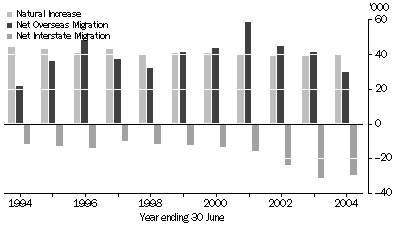
POPULATION AND HOUSEHOLDS, New South Wales - Selected years at 30 June |
|  |
 |  |  | 1994 | 2003 | 2004 |  |
|  |
| Estimated resident population | ('000) | 6 060.2 | 6 682.1 | 6 720.8 |  |
| Components of population change(a) |  |  |  |  |  |
 | Natural increase(b) | no. | 44 232 | 38 814 | 39 363 |  |
 | Net overseas migration | no. | 21 929 | 40 919 | 29 820 |  |
 | Net interstate migration | no. | -12 180 | -31 790 | -30 445 |  |
| Total increase(c) | no. | 55 310 | 47 943 | 38 738 |  |
| Annual growth rate | % | 0.92 | 0.72 | 0.58 |  |
| Estimated resident households(d) | ('000) | 2 210.4 | nya | nya |  |
| Projected households(e) | ('000) | . . | 2 528.4 | 2 565.9 |  |
|  |
| . . not applicable |
| nya not yet available |
| (a) From previous year. |
| (b) Excess of births over deaths. Births and deaths figures used to compile natural increase for population estimates are based on year of occurrence and may differ from births and deaths data based on year of registration displayed in the Births and Deaths sections of this paper. |
| (c) Includes intercensal discrepancy not accounted for by natural increase and net migration. |
| (d) Based on 1996 census data. |
| (e) Series II from Household and Family Projections, Australia, 2001-2026 (Cat. no. 3236.0). |
BIRTHS AND CONFINEMENTS
In the 2004 calendar year, there were 85,500 live births registered throughout Australia to mothers whose usual residence was in NSW. A further 400 live births were registered in NSW to mothers whose usual residence was overseas. Registrations of births were 0.5% lower than in 2003 (86,300) and 2.4% lower than in 1994 (88,000). In 2004, NSW had a crude birth rate of 12.8 births per 1,000 population, slightly higher than that for Australia (12.7 births per 1,000 population).
Total Fertility Rate
The total fertility rate for NSW in 2004 was 1.79 births per woman. This figure was above the Australian level of 1.77, but below the replacement level of 2.1 (the number of children each woman would need to have to replace herself and her partner).
TOTAL FERTILITY RATE, Australia and New South Wales - 1994-2004
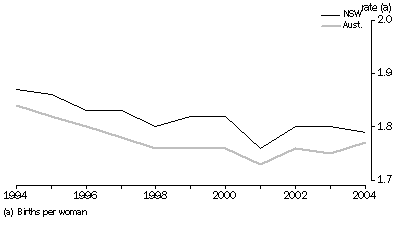
Median Age at Birth
The median age of mother at confinement continued to increase in 2004. The median age of mother for all confinements was 30.6 years, compared to 30.5 in 2003 and 29.0 in 1994. The median age of mother for all nuptial confinements was 31.4 years, while the median age for fathers was 33.6. The median age of mother for first nuptial confinements has also continued to increase from 28.4 years in 1994 to 30.2 in 2004.
BIRTHS AND CONFINEMENTS, New South Wales - Selected years(a) |
|  |
 |  |  | 1994 | 2003 | 2004 |  |
|  |
| Live births |  |  |  |  |  |
 | Number(b) | no. | 87 977 | 86 344 | 85 894 |  |
 | Crude birth rate(c) | rate | 14.5 | 12.9 | 12.8 |  |
 | Total fertility rate(d) | rate | 1.874 | 1.796 | 1.794 |  |
 | Net reproduction rate(e) | rate | 0.899 | 0.860 | 0.859 |  |
| All confinements |  |  |  |  |  |
 | Number | no. | 86 785 | 84 975 | 84 568 |  |
 | Median age of mother | years | 29.0 | 30.5 | 30.6 |  |
| Nuptial confinements |  |  |  |  |  |
 | Number | no. | 65 483 | 61 253 | 60 385 |  |
 | Median age of mother | years | 29.9 | 31.3 | 31.4 |  |
 | Median age of father | years | 32.4 | 33.5 | 33.6 |  |
| First nuptial confinements |  |  |  |  |  |
 | Number | no. | 26 267 | 26 310 | 25 680 |  |
 | Median age of mother | years | 28.4 | 30.1 | 30.2 |  |
|  |
| (a) Year of registration. |
| (b) Births registered in NSW, including births registered to women usually resident overseas. |
| (c) Births per 1,000 population. |
| (d) Births per woman. |
| (e) Daughters surviving to reproductive age per woman. |
DEATHS
In the 2004 calendar year, there were 46,400 registered deaths of people usually resident in NSW, an increase of 3.7% from the 44,800 deaths in 1994. The crude death rate decreased from 7.4 deaths per 1,000 population in 1994 to 6.9 deaths per 1,000 population in 2004. The standardised death rate also decreased over the same period, from 8.2 deaths per 1,000 population in 1994 to 6.3 deaths per 1,000 population in 2004.
CRUDE DEATH RATES(a), Australia and New South Wales - 1994-2004
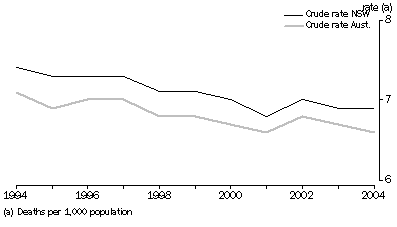
MEDIAN AGE AT DEATH
The median age at death has increased gradually for both males and females over the last 10 years. The median age at death for males (76.9 years) and females (82.7 years) in 2004 had increased by 3.4 years and 2.5 years respectively since 1994. The difference between males and females reduced from 6.6 years in 1994 to 5.8 years in 2004.
INFANT MORTALITY
There were 400 infant deaths (those aged less than one year) registered in 2004, a decrease of 27.6% since 1994 (550). In 2004, the infant mortality rate was 4.6 deaths per 1,000 live births. During the previous 10 years, the only year in which the infant mortality rate was lower than this was 1998 (4.3 deaths per 1,000 live births). The highest infant mortality rate during the same period occurred in 1994 (6.3 deaths per 1,000 live births).
LIFE EXPECTANCY
Life expectancy at birth in 2004 was 78.0 years for males and 83.3 years for females, representing increases of 3.1 years and 2.4 years respectively since 1994. The difference between male and female life expectancy has decreased in the 10 year period to 2004. In 1994, female life expectancy at birth was 6.0 years higher than that for males compared to 5.3 years in 2004.
DEATHS, New South Wales - Selected years(a) |
|  |
 |  |  | 1994 | 2003 | 2004 |  |
|  |
| Number | no. | 44 763 | 46 111 | 46 440 |  |
| Crude death rate(b) | rate | 7.4 | 6.9 | 6.9 |  |
| Standardised death rate(c) | rate | 8.2 | 6.4 | 6.3 |  |
| Median age at death |  |  |  |  |  |
 | Males | years | 73.5 | 76.3 | 76.9 |  |
 | Females | years | 80.1 | 82.6 | 82.7 |  |
| Infant deaths |  |  |  |  |  |
 | Number | no. | 551 | 398 | 399 |  |
 | Infant mortality rate(d) | rate | 6.3 | 4.6 | 4.6 |  |
| Life expectancy at birth(e) |  |  |  |  |  |
 | Males | years | 74.9 | 77.7 | 78.0 |  |
 | Females | years | 80.9 | 82.9 | 83.3 |  |
|  |
| (a) Year of registration. |
| (b) Deaths per 1,000 population. |
| (c) Deaths per 1,000 population. Standardised death rates use total persons in the 2001 Australian population as the standard population. |
| (d) Deaths per 1,000 live births. |
| (e) From 1995 onwards expectation of life has been calculated using three years of data. |
MIGRATION
NET OVERSEAS MIGRATION
In the 12 months to 30 June 2004, NSW recorded a net overseas migration gain of 29,800 people, the second lowest since 1994. This comprised 155,200 overseas arrivals and 98,000 overseas departures and was 27.1% lower than the 2003 gain and 49.1% lower than the 2001 peak of 58,600 people. The lowest overseas net migration figure over the last 10 years was 21,900 people in 1994. In 2004, NSW received 29.8% of Australia's net overseas migration, compared to 35.1% in 2003.
OVERSEAS MIGRATION, Permanent and long-term movements, New South Wales - 1994-2004
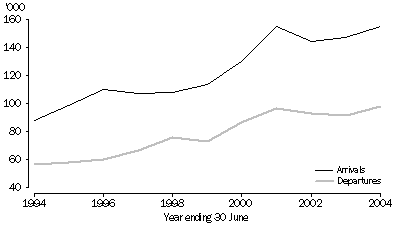
NET INTERSTATE MIGRATION
For the last 10 years, NSW has experienced a net interstate migration loss. Since the 12 months to 30 June 1994, the net interstate migration loss generally increased to a maximum loss of 31,800 people in 2003. While the net interstate migration loss for the 12 months to 30 June 2004 was slightly lower at 30,400 people it was still the largest loss of any state or territory for this period.
INTERSTATE MIGRATION, New South Wales - 1994-2004
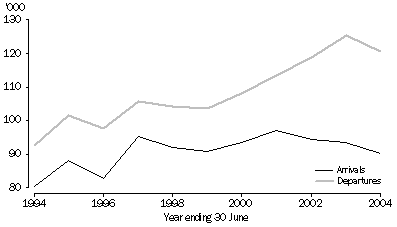
MARRIAGES
There were 37,400 marriages registered in NSW in the 2004 calendar year, an increase of 560 (or 1.5%) since the previous year. The number of marriages registered in NSW has declined by 1,400 (or 3.6%) since 1994.
The crude marriage rate in 2004 was 5.6 marriages per 1,000 population, a slight increase since 2003, but a decline from 6.4 marriages per 1,000 population in 1994. In the previous 10 years, the NSW crude marriage rate has exceeded the rate for Australia, except in 1996 and 1997 when the rates were the same.
CRUDE MARRIAGE RATES(a), Australia and New South Wales - 1994-2004
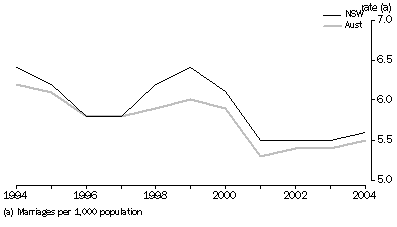
MEDIAN AGE AT MARRIAGE
In 2004, the median age at marriage of brides and bridegrooms reached 28.8 years and 31.2 years respectively, the highest figures recorded in the last 10 years. Since 1994, the median ages at marriage for brides and bridegrooms have increased by 2.2 years and 2.1 years respectively. The median age for bridegrooms has consistently remained around two years higher than that for brides.
MARRIAGES, New South Wales - Selected years(a) |
|  |
 |  |  | 1994 | 2003 | 2004 |  |
|  |
| Number registered | no. | 38 814 | 36 872 | 37 431 |  |
| Crude marriage rate(b) | rate | 6.4 | 5.5 | 5.6 |  |
| Median age at marriage |  |  |  |  |  |
 | Bridegroom | years | 29.1 | 30.9 | 31.2 |  |
 | Bride | years | 26.6 | 28.8 | 28.8 |  |
|  |
| (a) For 2004, marriage registrations were sampled for New South Wales and therefore subject to sampling error. |
| (b) Marriages per 1,000 population. |
DIVORCES
In the 2004 calendar year, there were 15,000 divorces granted in NSW. This represents a decrease of 1,300 (7.8%) divorces since 2003 and an increase of 1,000 (7.2%) divorces since 1994. The crude divorce rate in 2004 was 2.2 divorces granted per 1,000 population. In the ten years to 2004, the crude divorce rate has remained relatively stable.
The median interval between marriage and separation increased from 6.8 years in 1994 to 7.6 years in 2004. The median duration of marriage has also increased over the same period, from 10.0 years in 1994 to 11.2 years in 2004.
DIVORCES, New South Wales - Selected years |
|  |
 |  |  | 1994 | 2003 | 2004 |  |
|  |
| Number granted | no. | 13 999 | 16 285 | 15 007 |  |
| Crude divorce rate(a) | rate | 2.3 | 2.4 | 2.2 |  |
| Median duration of marriage |  |  |  |  |  |
 | To separation | years | 6.8 | 7.9 | 7.6 |  |
 | To divorce | years | 10.0 | 11.4 | 11.2 |  |
|  |
| (a) Divorces per 1,000 population. |
RELATED LINKS
Demographic data for all New South Wales statistical local areas are available from the data cube linked on the Details tab at the top of this page.
From the Related Information Tab there are links to other releases providing more specific or in-depth analysis and information.
 Print Page
Print Page
 Print All
Print All